Refocused Lens: Viewpoints, Contemporary Aboriginal photography
By Naomi Takeifanga | 22 October 2021
An exciting exhibition at State Library celebrates new narratives, Indigenous representation, and identity in contemporary photography. The works of First Nations artists Michael Aird, Jo-Anne Driessens and Naomi Hobson are included in Viewpoints curated by Georgia Walsh. This is the first in a series of blogs taking a deeper look into the importance of this exhibition and the stories that are held within it. At the core of each photographer’s work is a desire to involve Aboriginal people in the creation and custodianship of contemporary stories for future generations. Viewpoints is a free exhibition on show until 13 Feb 2022 in the Philip Bacon Heritage Gallery, level 4. If you are unable to view in person you can explore the exhibition and collections online at www.slq.qld.gov.au/viewpoints
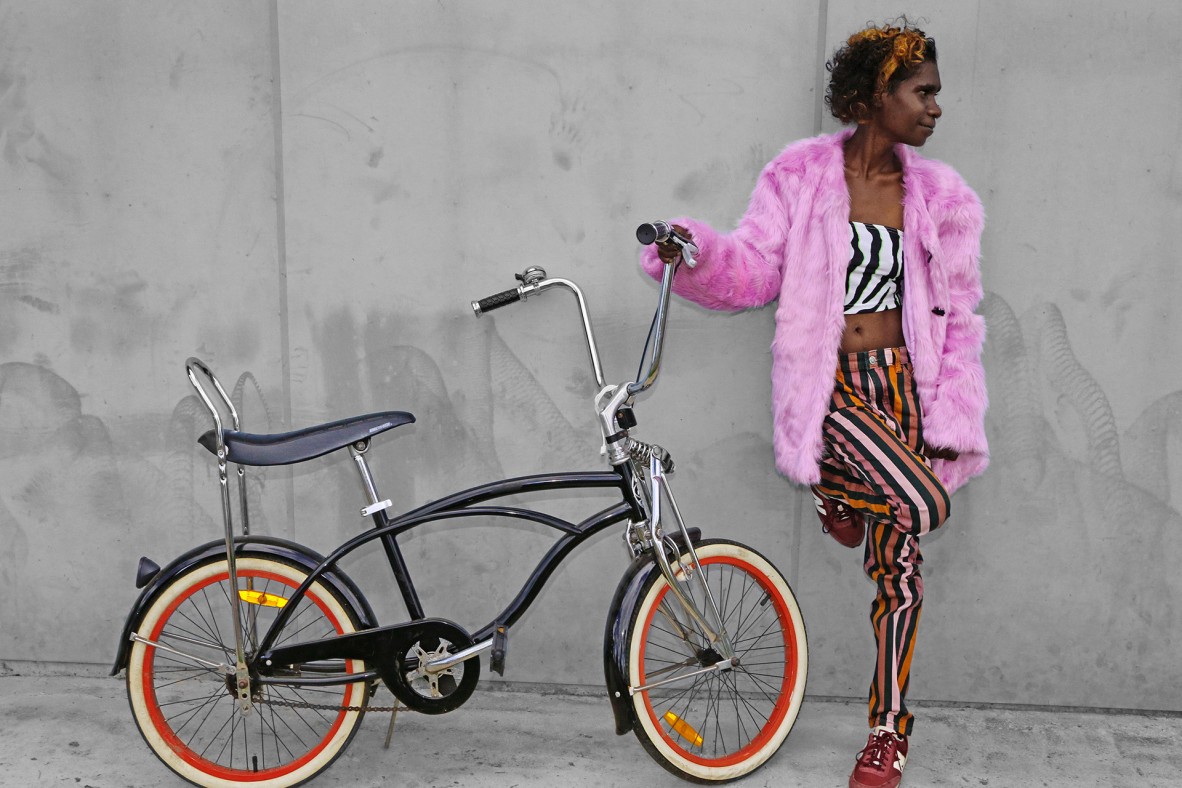
Daley’s Bike, Naomi Hobson (2019) Adolescent Wonderland photographic artworks,
John Oxley Library, State Library of Queensland, Image number: 32564-0001-0001
Cultural institutions are on the precipice of change that has been a long time in the making, a long-time of collecting from colonial perspectives, and telling stories on behalf of First Nations people. The change is becoming more obvious as you walk throughout cultural institutions, where the approach of “nothing about us without us” is being enacted.
This approach is in direct conversation with the biased collecting narrative that has been the hallmark of almost every western cultural organisation. The stories collected have been of the discoverers and explorers, then moved to the colonists and the protectors, these collections and stories have been told mainly through the lens of European descended males. Aware of the limited perspectives, the gendered and unbalanced power narrative, cultural institutions such as State Library are actively looking for the gaps and redirecting the collection opportunities to share a more balanced story of this state, this nation, and our place within the world.
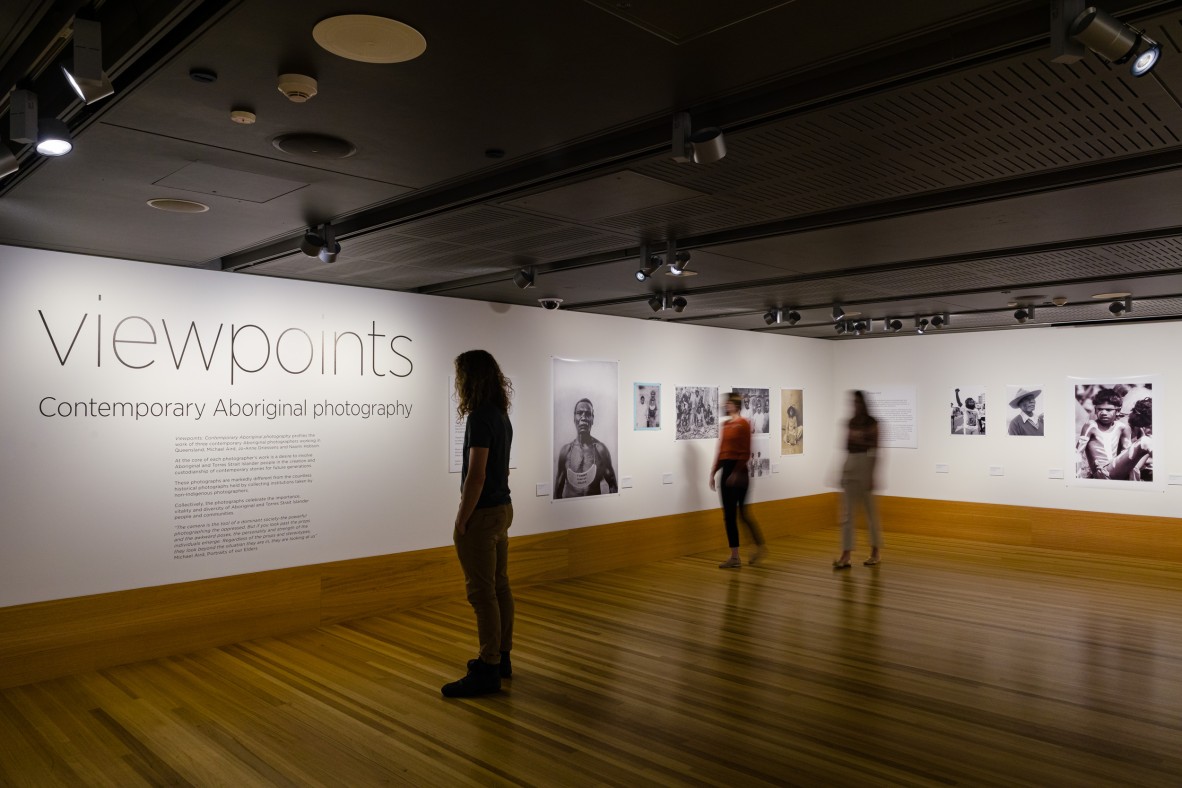
Viewpoints gallery view
This exhibition is a direct result of that ongoing change which started in the mid 2000s with State Library's introduction of the kuril dhagun team and the introduction of the Indigenous Knowledge Centres throughout Queensland. kuril dhagun is both a space for First Nation’s voices, more importantly it has been a team of passionate exhibitions, programming and community liaison staff who have led strong public programs celebrating the rich cultural stories and exposing the dark history of this state. The long legacy of this work enabled productive conversations with First Nations photographers, and ensuring the inclusion of these works in the collection has seen the acquisition of works from all three photographers, Michael Aird, Jo-Anne Driessens, and Naomi Hobson over the last decade. State Library staff have also worked closely with the historical photographic collection and shared it with community to provide access to these images hidden in collections, and most importantly provide much needed contextualisation of the historical practices of collecting data and capturing images without expressed consent or personal acknowledgement.
There is a power in this exhibition as it continues the important work of State Library, most importantly the kuril dhagun staff working with First Nations artists and curators leading this important journey. Viewpoints changes the status quo, changes the power dynamic, and most importantly tells the story of our First Nations people by First Nations people.
I had the privilege of spending time in Viewpoints, looking deeply into the sombre historical images of Aboriginal people contrasted with contemporary photos of places and spaces, community leaders and identities, joyful children, pivotal events, and everyday moments. The general feeling of this exhibition is that it is a prelude to a much larger story, and that is exciting. State Library has been collecting works from First Nations photographers since the late 1990s. With renewed vigour the acquisition last year of a selection of Naomi Hobson’s Adolescent Wonderland series, which are striking in both their focus on the vibrant people of Coen, and the playfulness and power embedded in each person and space.
Contrasted with the power of the historical photos. The resilience in the eyes and stance of Tommy the king of Noosa and the stoic Maria, queen of Childers, with proclamation of being the queen of all this land. Curator Georgia Walsh reminds us that these titles and breastplates hold complex meanings for Aboriginal people today, as they are both a rare form of evidence linking Aboriginal people to Country and a lasting reminder of acts of dispossession, settlement, and discrimination.
Michael Aird and Jo-Anne Driessens works are strikingly beautiful moments captured in time, dating back to 1987. Starting with Aird’s iconic photo of Vincent Brady leading an anti-bicentennial protest in Brisbane, with a freshly printed t-shirt emblazoned with no truer words spoken, “We have survived, white Australia has a black history.” In the lead up to the 1988, marking 200 years of brutal colonisation, protests by Aboriginal and Torres Strait Islander people and their allies were the largest ever seen across Australia.
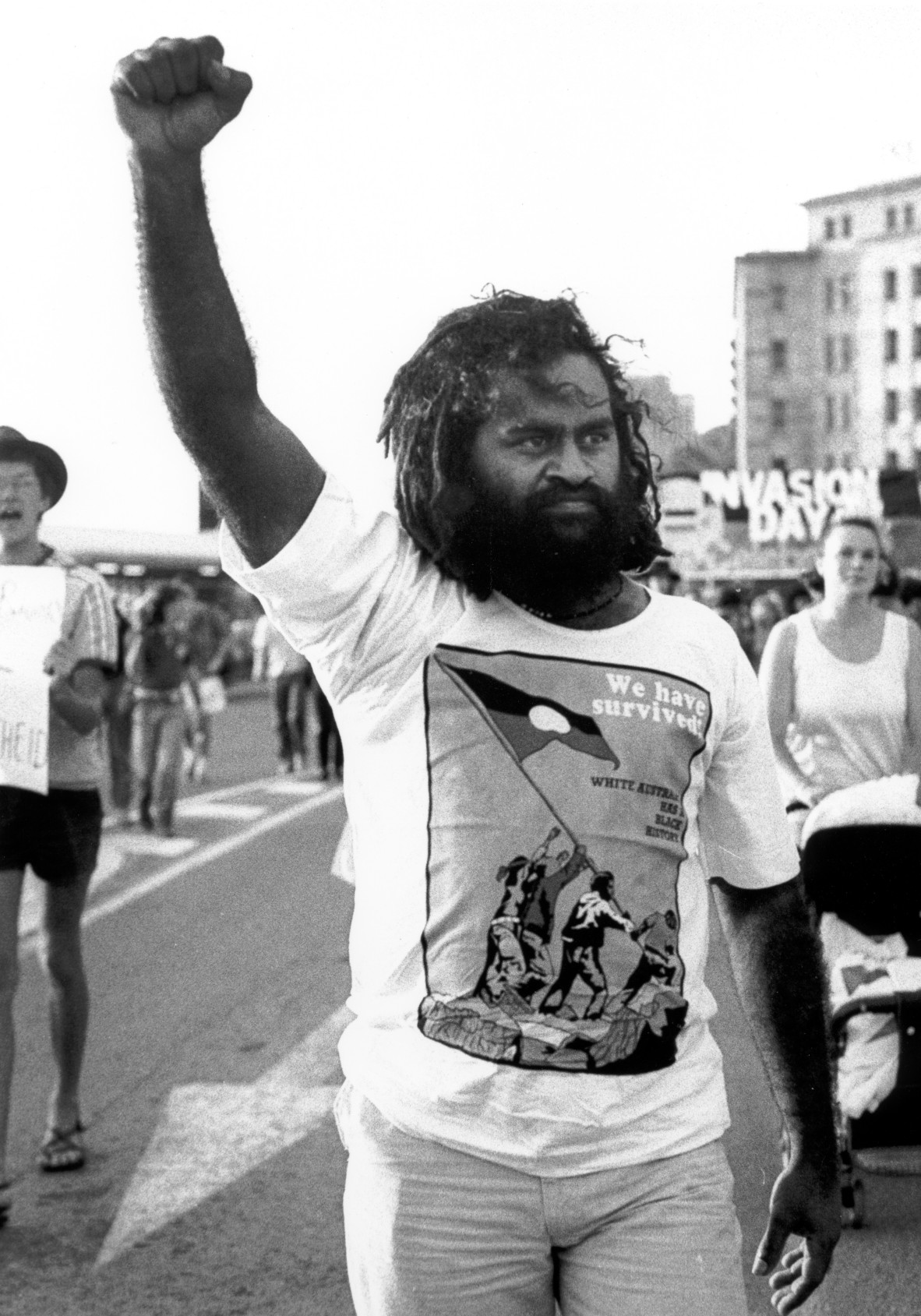
Vincent Brady leading an anti-Bicentenary protest in Brisbane, Michael Aird (1987)
Michael Aird Photographs, John Oxley Library, State Library of Queensland, Image number. 30300-0001-0067
Aird has beautiful timing, obvious in his portrait of Cyril Williams when he visited his traditional country around Beaudesert, with both a sense of belonging and a longing for what could have been. A few photographs capture young male dancers who all seem to embody a sense of pride and the strength of ancestors helping them through the cultural movements.
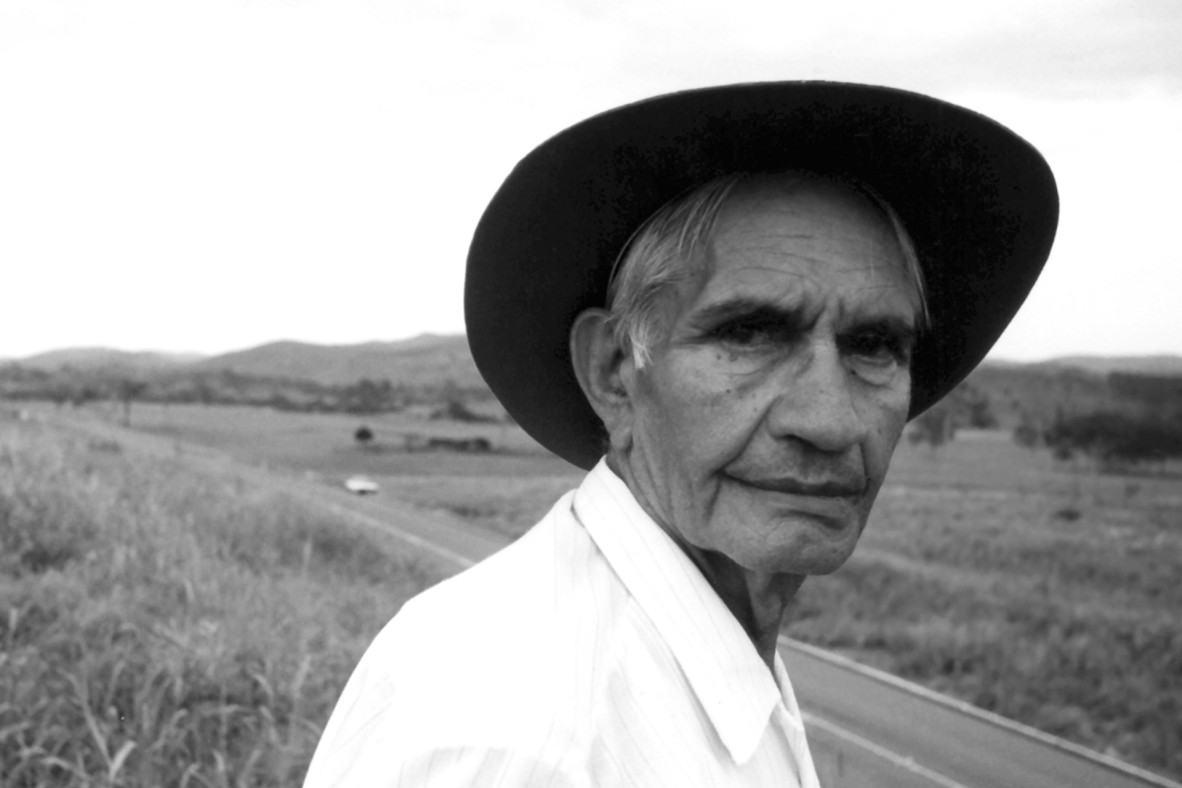
Cyril Williams visiting his traditional country in the Beaudesert District, Michael Aird (1992)
Michael Aird Photographs, John Oxley Library, State Library of Queensland. Image number: 30300-0001-0001
Jo-Anne Driessens has a long connection to State Library and her collection as with Aird’s will continue to grow. Driessens was awarded the Mittelheuser Scholar-in-Residence in 2021 to look at the representation of First Nations creatives and growing a dialogue with collecting institutions. Driessens works in the exhibition have a sublime sense of deep connection to land and connection between the people photographed together which exudes a quiet calm and power through all the works, much like Driessens herself.
One of the most moving images is of two elderly men at the Ny-Ku Byun aged care facility in Cherbourg (1997-2000). These men sit on a wooden bench close together, one nestling up to the others welcoming arms. The tenderness of this moment is palpable, it transcends human connection, these men are bonded in ways we cannot even imagine. These move beyond photographs, they are moments in time and place that are so inviting you wish you could step into the world, grab a cuppa, and listen to their stories that cover millennia. The image itself has two perfect halves, the left side with the men, and the right side a long corridor, devoid of personality, with another seat just visible on the edge, a hint of a whole other story perhaps.
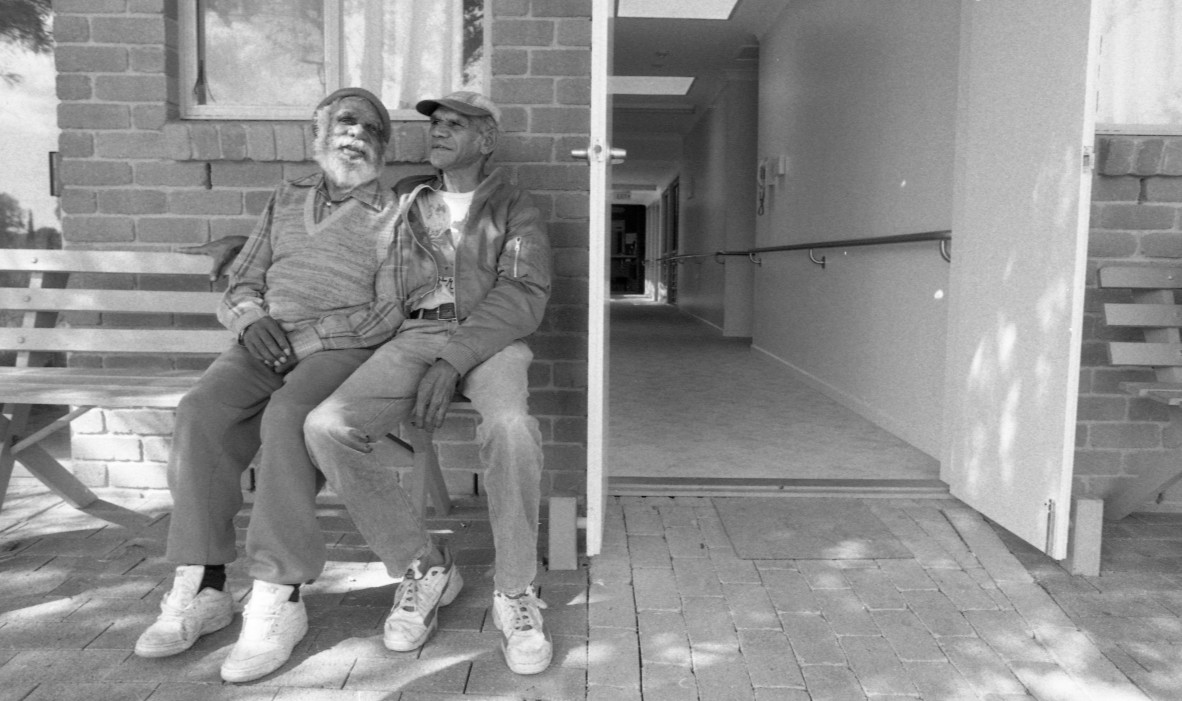
Aboriginal men at the Ny-Ku Byun aged care facility in Cherbourg, Jo-Anne Driessens (1997-2000)
Jo-Anne Driessens Photographs, John Oxley Library, State Library of Queensland. Image number: 30299-0001-0010
Driessens works magnify the intergenerational importance of learning. The image of Maureen Watson and her grandchildren at the Woodford Folk Festival in 1998 is as playful as it is meaningful. Maureen’s grandchildren follow her moves and embody hope for the future, where their culture and identity are celebrated throughout his land, their lands.
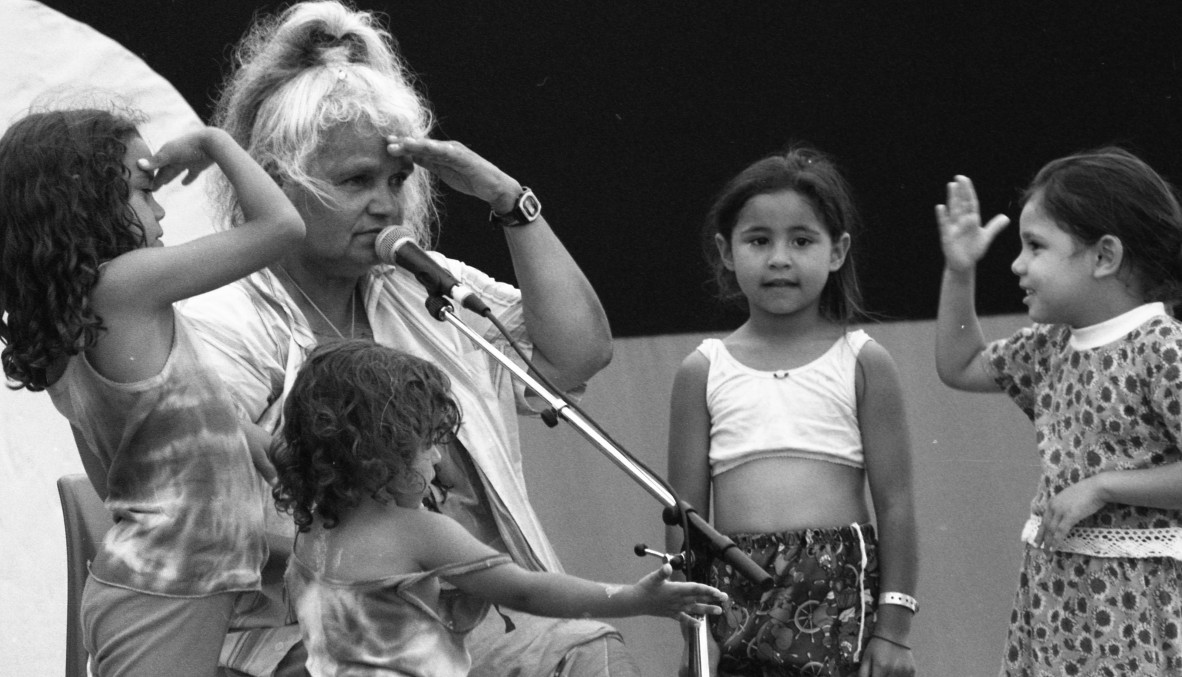
Maureen Watson and grandchildren at the Woodford Folk Festival, Jo-Anne Driessens (1998)
Jo-Anne Driessens Photographs, John Oxley Library, State Library of Queensland. Image number: 30299-0001-0040
Naomi Hobson’s photographs are the most contemporary in the exhibition and are evident of Hobson’s multidisciplinary approach to her art and a very deep connection to her country, ancestors, and the continued connection with her traditional lands. Imbued with the effervescent fusion of indigenous culture with pop culture.
Immediately I am drawn to Road Play, the playfulness between the kids, the younger in dress-up and the teenager perched on a bike taking selfies! Instead of taking her younger sibling for a ride! The image exudes happiness, Hobson has created this wonderland of reality that makes you want to jump inside and explore more.
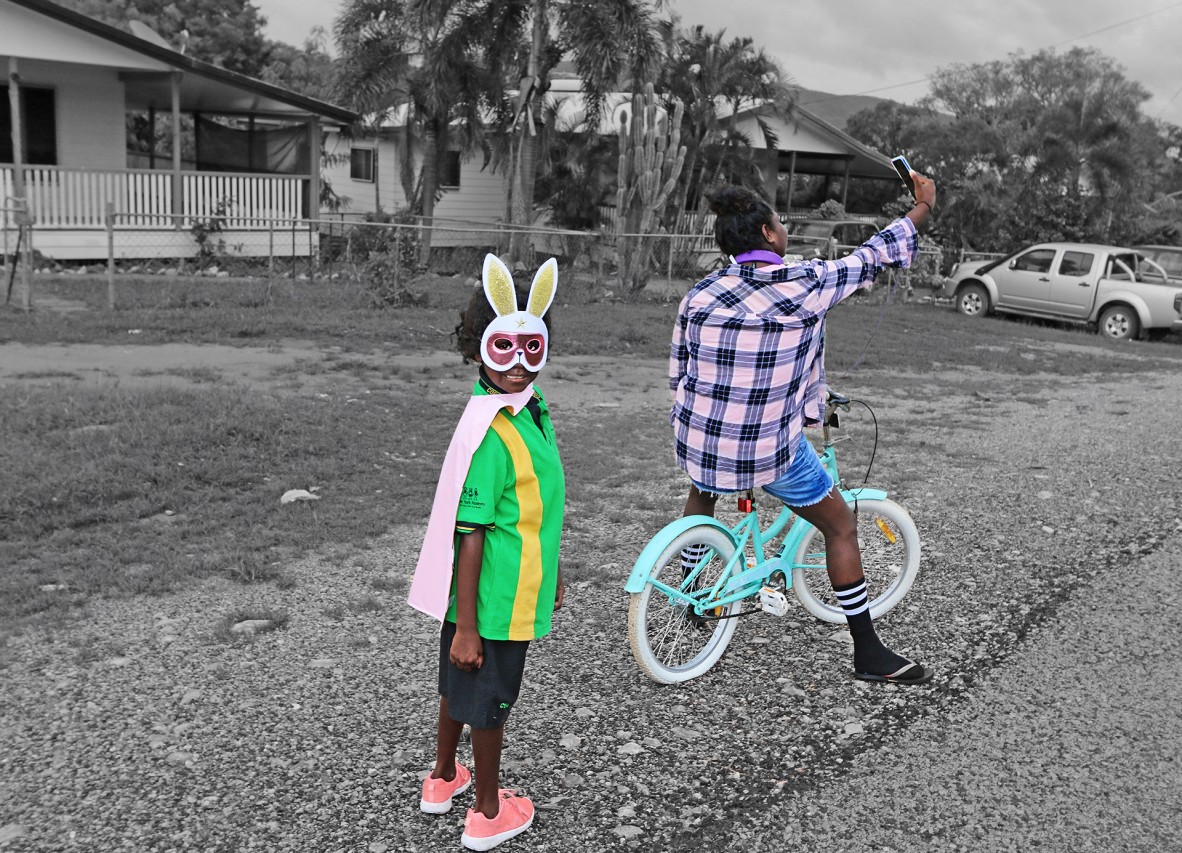
Road Play, Naomi Hobson (2019) Adolescent Wonderland photographic artworks,
John Oxley Library, State Library of Queensland, Image number: 32564-0001-0002
State Library is proud of the new learning portal, connecting collection content to the Australian curriculum. The exhibition resource on Curriculum Connect accompanying the exhibition is designed for teachers implementing Senior Visual Art Unit 2 Art as code or a Visual Arts in Practice photography unit. Students will explore historical and contemporary photography in the State Library’s collection and consider the viewpoints of photographers and subjects through the themes of representation, identity, and agency.
The legacy of this exhibition and the ongoing collection of First Nations photographic work will ensure that the stories and people are honoured and will continue to see exhibitions with embedded First Nations perspectives.
State Library of Queensland commitments statement:
The material displayed contains Aboriginal and Torres Strait Islander content and has been made available in accordance with State Library of Queensland’s Aboriginal and Torres Strait Islander Collections Commitments.
Read more about the Aboriginal and Torres Strait Islander material accessed on the State Library of Queensland website.
Aboriginal & Torres Strait Islander Collections | State Library of Queensland (slq.qld.gov.au)
Collection links:
Curriculum Connect: Viewpoints: Contemporary Aboriginal photography (slq.qld.gov.au)
Michael Aird, 30300 Michael Aird Photographs 1980s- 2000s (1980)
Jo-Anne Driessens, 30299 Jo-Anne Driessens Photographs 1997-2000 (1997)
Naomi Hobson, 32564, Adolescent Wonderland photographic artworks (2019)
Michael Aird and Queensland Museum. Portraits of Our Elders / Michael Aird (1993). Print.
Michael Aird and Dennis Conlon. Brisbane Blacks / Michael Aird. (2001). Print.
First Nations photography, reframed: ‘This is who we really are’ | Photography | The Guardian
January twenty-six | State Library Of Queensland (slq.qld.gov.au)
Comments
Your email address will not be published.
We welcome relevant, respectful comments.